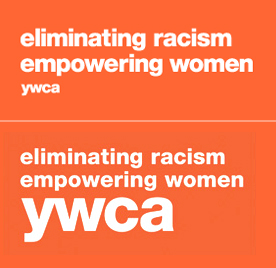Quick Quiz:
What is the mission of the YWCA?
Answer:
I didn’t know either.
The good news is that when you see the new YWCA logo (I’ll show you in a minute), you will know exactly what their mission is.
Really, this is actually quite an accomplishment. It is very hard, if not impossible to convey that type of information through a logo. These don’t do it. You could have a tree as a logo, if you wanted to represent nature or growth, but even that doesn’t convey mission. Now, the YWCA’s mission is “Eliminating racism, empowering women.” So, what is their new logo? A leaping person? A smile? No. This is the new YWCA logo . Not just the name, but the whole thing. It is quite amazing and as Michael Bierut stated in “The Tyranny of the Tagline” on Design Observer, “it’s amazing it hasn’t been done before.”
The previous identity was created in 1988 at Bass/Yager & Associates. That logo, “a stylized ‘W’ enclosing a sunrise which suggests the letter ‘Y’” was fairly successful in that by emphasizing the “W”, it was able to distance itself from the YMCA, with which it is constantly confused. It did not however add meaning to the YWCA, which is what it needed. It was a fine logo, but what is interesting to me is that the recommended version, much like United Way, had a gradation, which seems unnecessary and inconvenient for small, local not-for-profits. The tapered lines, which Saul Bass loved so much, created enough dimension.
The new identity was created by Landor, which was selected from a field of 48 firms that responded to the YWCA’s request for proposals. Landor actually competed against only 5 others that were invited to make presentations in March of 2003. Four months after winning the assignment, Landor presented 6 design concepts and one entitled, “Hallmark” was chosen.
As far as the design, the concept is brilliant: No one knows what the hell we do, so let’s elevate that message to the highest visibility. There are actually two versions of the logo. One uses the name small and the other reverses the hierarchy. This is good, although it is yet unclear when and how each will be used. Right now, the version with the small name is used in the national website while the other is interspersed throughout their annual report and both are used on various merchandise.
One problem I have with the design is that it seems to be straight Helvetica. A major problem with organizations that are decentralized, is that a lot of liberties are taken with the national identity at a local level. This identity, especially with its two size variations, is inviting alterations. The fact that it looks “typed in”, is inviting people to create their own version. That is a problem. Often, simple wordmarks will have a small but noticeable design element incorporated in the type to discourage this.
One of the most important aspects of identity work is internal buy-in. You need to have people on board in order for it to be successful. Here is a quote from a regional YWCA representative: “Responses to the new brand have been strong in both directions. Within our own region, we received negative responses from at least half of the Associations. Several positive responses were received as well.” Only time will tell how successful the new identity is and how many locals embrace it. Local YWCA’s have until December of 2005 to be fully compliant with the new identity.
It’s not too often that you can do something new or innovative in branding or design and that is exactly what was done. Overall, I like the new YWCA identity. Again, the mission of this identity was to convey the mission of YWCA. Mission accomplished.
* Special thanks to Design Maven for research, knowledge and passion in addition to amazing archive material.



























 this is from the Victoria website
this is from the Victoria website



 This is from Yonkers website.
This is from Yonkers website.
Mission accomplished. I like the new identity because there's clear rational behind the change, and smart, new thinking behind the execution.
The YWCA brand was well-known and had differentiation, but had lost all relevance to people. In other words, people recognized and knew the mark, but didn't care. This new identity brings that relevance back full force.
Bravo.
On Jul.06.2004 at 11:08 AM